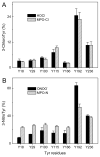Site-specific oxidation of apolipoprotein A-I impairs cholesterol export by ABCA1, a key cardioprotective function of HDL
- PMID: 22178192
- PMCID: PMC3288272
- DOI: 10.1016/j.bbalip.2011.11.011
Site-specific oxidation of apolipoprotein A-I impairs cholesterol export by ABCA1, a key cardioprotective function of HDL
Abstract
The mechanisms that deprive HDL of its cardioprotective properties are poorly understood. One potential pathway involves oxidative damage of HDL proteins by myeloperoxidase (MPO) a heme enzyme secreted by human artery wall macrophages. Mass spectrometric analysis demonstrated that levels of 3-chlorotyrosine and 3-nitrotyrosine - two characteristic products of MPO - are elevated in HDL isolated from patients with established cardiovascular disease. When apolipoprotein A-I (apoA-I), the major HDL protein, is oxidized by MPO, its ability to promote cellular cholesterol efflux by the membrane-associated ATP-binding cassette transporter A1 (ABCA1) pathway is diminished. Biochemical studies revealed that oxidation of specific tyrosine and methionine residues in apoA-I contributes to this loss of ABCA1 activity. Another potential mechanism for generating dysfunctional HDL involves covalent modification of apoA-I by reactive carbonyls, which have been implicated in atherogenesis and diabetic vascular disease. Indeed, modification of apoA-I by malondialdehyde (MDA) or acrolein also markedly impaired the lipoprotein's ability to promote cellular cholesterol efflux by the ABCA1 pathway. Tandem mass spectrometric analyses revealed that these reactive carbonyls target specific Lys residues in the C-terminus of apoA-I. Importantly, immunochemical analyses showed that levels of MDA-protein adducts are elevated in HDL isolated from human atherosclerotic lesions. Also, apoA-I co-localized with acrolein adducts in such lesions. Thus, lipid peroxidation products might specifically modify HDL in vivo. Our observations support the hypotheses that MPO and reactive carbonyls might generate dysfunctional HDL in humans. This article is part of a Special Issue entitled Advances in High Density Lipoprotein Formation and Metabolism: A Tribute to John F. Oram (1945-2010).
Copyright © 2011 Elsevier B.V. All rights reserved.
Figures






Similar articles
-
Pathways for oxidation of high-density lipoprotein in human cardiovascular disease.Curr Opin Mol Ther. 2006 Jun;8(3):198-205. Curr Opin Mol Ther. 2006. PMID: 16774039 Review.
-
Modifying apolipoprotein A-I by malondialdehyde, but not by an array of other reactive carbonyls, blocks cholesterol efflux by the ABCA1 pathway.J Biol Chem. 2010 Jun 11;285(24):18473-84. doi: 10.1074/jbc.M110.118182. Epub 2010 Apr 8. J Biol Chem. 2010. PMID: 20378541 Free PMC article.
-
Oxidation of apolipoprotein A-I by myeloperoxidase impairs the initial interactions with ABCA1 required for signaling and cholesterol export.J Lipid Res. 2010 Jul;51(7):1849-58. doi: 10.1194/jlr.M004085. Epub 2010 Jan 11. J Lipid Res. 2010. PMID: 20064972 Free PMC article.
-
Tyrosine 192 in apolipoprotein A-I is the major site of nitration and chlorination by myeloperoxidase, but only chlorination markedly impairs ABCA1-dependent cholesterol transport.J Biol Chem. 2005 Feb 18;280(7):5983-93. doi: 10.1074/jbc.M411484200. Epub 2004 Nov 30. J Biol Chem. 2005. PMID: 15574409
-
Myeloperoxidase: an oxidative pathway for generating dysfunctional high-density lipoprotein.Chem Res Toxicol. 2010 Mar 15;23(3):447-54. doi: 10.1021/tx9003775. Chem Res Toxicol. 2010. PMID: 20043647 Free PMC article. Review.
Cited by
-
HDL Structure.Adv Exp Med Biol. 2022;1377:1-11. doi: 10.1007/978-981-19-1592-5_1. Adv Exp Med Biol. 2022. PMID: 35575917
-
Molecules that mimic apolipoprotein A-I: potential agents for treating atherosclerosis.J Med Chem. 2014 Mar 27;57(6):2169-96. doi: 10.1021/jm4005847. Epub 2013 Oct 29. J Med Chem. 2014. PMID: 24168751 Free PMC article. Review.
-
The Application of a Modified d-ROMs Test for Measurement of Oxidative Stress and Oxidized High-Density Lipoprotein.Int J Mol Sci. 2017 Feb 21;18(2):454. doi: 10.3390/ijms18020454. Int J Mol Sci. 2017. PMID: 28230785 Free PMC article.
-
Regulation of protein function by reversible methionine oxidation and the role of selenoprotein MsrB1.Antioxid Redox Signal. 2015 Oct 1;23(10):814-22. doi: 10.1089/ars.2015.6385. Epub 2015 Jul 16. Antioxid Redox Signal. 2015. PMID: 26181576 Free PMC article. Review.
-
Comparative Proteome Analysis Reveals Lipid Metabolism-Related Protein Networks in Response to Rump Fat Mobilization.Int J Mol Sci. 2018 Aug 28;19(9):2556. doi: 10.3390/ijms19092556. Int J Mol Sci. 2018. PMID: 30154394 Free PMC article.
References
-
- Braunwald E. Biomarkers in heart failure. N Engl J Med. 2008;358:2148–2159. - PubMed
-
- Brown MS, Goldstein JL. A receptor-mediated pathway for cholesterol homeostasis. Science. 1986;232:34–47. - PubMed
-
- Berliner JA, Heinecke JW. The role of oxidized lipoproteins in atherogenesis. Free Radic Biol Med. 1996;20:707–727. - PubMed
-
- Heinecke JW. Oxidants and antioxidants in the pathogenesis of atherosclerosis: implications for the oxidized low density lipoprotein hypothesis. Atherosclerosis. 1998;141:1–15. - PubMed
Publication types
MeSH terms
Substances
Grants and funding
LinkOut - more resources
Full Text Sources
Medical
Research Materials
Miscellaneous

